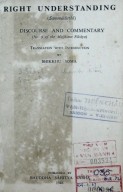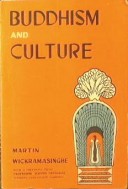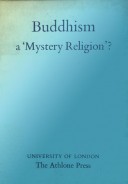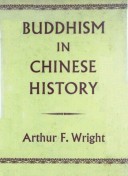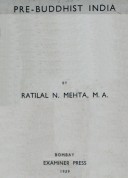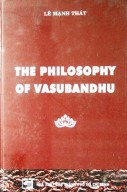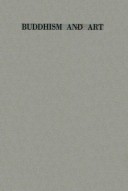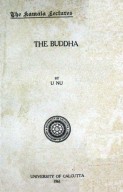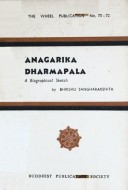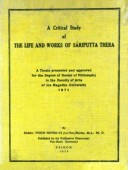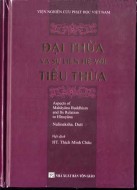Tìm Sách
Sách tiếng Anh-English >> Right Understanding
Thông tin tra cứu
- Tên sách : Right Understanding
- Tác giả : Bhikkhu Soma
- Dịch giả : Bhikkhu Soma
- Ngôn ngữ : Anh
- Số trang : 58
- Nhà xuất bản : Bauddha Sahitya Sabha
- Năm xuất bản :
- Phân loại : Sách tiếng Anh-English
- MCB : 1210000003594
- OPAC :
- Tóm tắt :
Right Understanding
Discource and Commentary
No. 9 of the Majjhima Nikaya
INTRODUCTION
Buddhism is the mental highway to complete liberation hewn out by the Buddha and is different from all other roads to salvation. As the Buddha-road, so is the Buddha-goal distinct from everything non-Buddhist. The Buddha-goal is in a direction where no other goals are.
Non-Buddhist goals appear somehow to exist at one point or another in the conceptual space of man’s changing world of mind. And these even in their more refined formulations cannot make us forget the five aggregates of sentient existence (the pancakkhandha) from which they are fashioned like Eve out of Adam’s rib. There is only one goal, the Buddha’s, where one cannot find anything of material form (rupa), feeling (vedanã), perception (sanna), volition (sankhãra) and conceiving (vinnana) which afford fresh bases for revolving in Samsara.
In this goal of the Buddha, ignorance cannot sprout again because here ignorance is destroyed root and branch; and discord cannot arise because the passions have been scorched out one and all. Here, as there is a drying up of the river of becoming entirely from its source of craving downwards, nothing that smacks of the world of life and death, of materiality and mentality, finds a place. Nibbana is away from every point in the universe and beyond all temporal and spatial limitations.
Further, the Buddha-word moves through a domain that is fully new territory of wisdom to the worldling. This wisdom is not particularly the product of devotion (bhatti), action (kamma), intellection (buddhi) or meditation (bhãvanã), but a working into the mind of the yogavacara (the man yoked to spiritual practice) a new stuff distilled in the depths of freedom’s realisation which penetrates through every particle of the yogin’s experience and culminates in a catastrophe for the very foundations of craving.
The stuff of freedom which at once eradicates all forces of ill and releases all powers for highest happiness in the spiritual aspirant is the end-result of a progressive reversion of the life-process from grasping to ungrasping, from selfish coherence to clean detachment and from the devouring of conceptual nourishment to a denial of all such food. It is the quality which animates the alteration of the stream of action from a movement of becoming to a dissipation of that movement and a scattering of it, through the deliberate abandonment of every strand of the lust for living. It follows the sensing of the unique peace of heart at the moment of separation from lust, hate and nescience, in the silence of non- willing which occurs when life is directly realised as it is, through the resplendence of right understanding, and the path to perfect self-mastery and emancipation opens out.
With the realisation of right understanding one can be said to have made a new interpretation of the world, an interpretation, authentic, useful, fully interesting, and tranquillizing, because it is a correct view of life, its meaning and its highest possibilities for genuine holiness and purity.
Such an interpretation is charged with the serenity and poise of a clear standpoint. It is neither optimistic nor pessimistic since optimism and pessimism are children of passion and defilement and cannot enter into any true sizing up of things in the Buddhist way. The Buddhist standard of judgment is planted firm in actuality; it veers neither to right nor left, to flabby sensuality nor grim asceticism, but steadily moving away from all extremes and crookednesses, in all its decisions, measures up phenomena, impartially and justly.
To this right understanding which is of supreme importance for the conquest of the highest and the enjoyment of the nectar of immortality, Nibbãna, we have only one way, the way of the Buddha whose every word radiates the wisdom that liberates.
Right understanding in the highest sense of the term is the ultramundane understanding of the Perfect One, the Arahant, “whose view is upright” and who “abandoning all passion, leaving the round of rebirth, finishing the practice, is come into the Good Norm plunged in the deathless called Nibbãna.”
Right understanding when it is in people outside the Buddha’s Dispensation is founded only on a belief in moral causation (kamma). They believe that one is the heir of one’s action, that one reaps as one sows, and that there is a life after this present one.
Those within the Buddha’s Dispensation possess the right understanding that is founded on the belief in moral causation;and rebirth and also on the knowledge that accords to the Four Real Truths (cattãri ariya saccãni). Owing to this last mentioned knowledge, the Buddhist is not tainted by ideas of an ens, soul or self.
It is with the full penetration of the knowledge of the Four Real Truths that right understanding becomes complete. One could fully penetrate the true nature of the world and reach the understanding that frees one from suffering for ever only through the entire comprehension of the Four Real Truths because they contain everything mundane and ultramundane. There is nothing at all that does not get included in these Four Truths (catu sacca vini-mutto dhammo nãma natthi).
In the Discourse given here the method of comprehending the Truths and gaining right understanding is explained in a multiplicity of ways suited for driving deep into the consciousness of the candidate for salvation, the saving knowledge. The ways of explanation are sixteen in number, but they can be reduced to the following four: explanation by way of moral causation, by way of the Four Truths directly, by way of nutriment and by way of dependent origination. The last form of explanation is treated in thirteen different relations.
MORAL CAUSATION
Moral causation (kamma) is shown as the ten skilful actions (kusala kamma) such as non-killing and so forth, and the ten unskilful actions (akusala kamma) such as killing and so forth.
Skill is beneficent action, behaviour that is meritorious, conducive to happiness here and hereafter.
Unskill is maleficent action, behaviour that is demeritorious, leading to misery here and hereafter.
It is through a knowledge of moral causation and by doing what is skilful and refraining from what is unskilful that one is able to preserve one’s humanity intact, and progress spiritually.
Actions that are unskilful lower one in the scale of being, retard one’s growth in every way and bring about the loss of one’s laboriously acquired skills. Skilful actions strengthen, elevate, and lead one to higher and higher states of well-being.
Therefore, one should try to understand rightly the fact of moral causation, by a close investigation of the conditions of existence and through the study and contemplation of the results of good and evil action in one’s own mind and life, and in the lives of others.
It is undeniable that a moral life is necessary to live untroubled in society, and bear Oneself up well in adversity and prosperity. Without a personality that is rich in moral strengths life becomes insipid through a falling away in intellectual vigour and clarity, and emotional poise; and under such conditions no character can be built up which will stand one in good stead at all times, and especially in times of crises. But a personality that is fully endowed morally can weather the storms of life with comparative ease and turn even the most unlikely situations to account.
THE FOUR REAL TRUTHS
The Four Real Truths are suffering; its cause; its ceasing; and the way which brings about its ceasing.
The fact that the world is subject to suffering needs no elaboration. It is patent to all but the utterly foolish, fully unthinking crowd. Still the world’s subjection to suffering is deeper than the usual appreciation of the fact by the majority.
Suffering broods over the disorderly passionate mind of the worldling as the spirit of God over chaos, in religious legend.
Suffering bears the seal of subjection to circumstances and is oppression, torture, vicissitude, change for the worse and a thing put-together.
Comfort which life yields is evanescent as a bubble. Pleasure when it changes and pain while it lasts are suffering. And since pleasure passes quickly, and pain cannot be kept out long, life is overwhelmingly suffering to the thoughtful.
Harassment, annoyance and vexation are the standout features of suffering. The function of suffering is to torment and its manifestation is in the form of a process.
The origin of suffering is craving—a hunger that cannot be filled though the whole world serves for a food-trough.
Indulgence of craving is irksome, because the more one yields to craving the more it grows.
The nature of craving is to gather in, and to accumulate. It is a matrix, bond and an obstacle. Craving is ignorance grown to action and is a name for purblind instinctive movements of sentient life. Behind all discord and conflict, behind all spoliations and injustice, craving lurks.
The state of being a cause is the salient feature of craving ; its function is holding fast to a thing—not breaking loose from a thing— and its manifestation is of the character of a hindrance.
The cessation of suffering is the cessation of craving. Through the ending of craving all turmoil and strife end, rest is reached and Nibbãna attained. The pre-eminent sign of craving’s cessation is peace; its function is the bestowal of immortality and it manifests itself as separation from the characteristics of the five-fold aggregate.
The way that brings about the cessation of suffering is the Real Eightfold Path (ariya atthangika magga) headed by right understanding. The quality of leading out from suffering to bliss, of being a cause that destroys what clouds the realisation of Nibbãna, of possessing clear perception, vision or insight and the quality of fitness of its constituents for the conquest of the highest good must be regarded as the nature of the way that ends all conceivable ill.
The outstanding characteristic of the way that brings about the ending of ill is its nature of leading beings away from Sam Sara to Nibbãna; the abandoning of the defilements is its function; and the getting away from states of becoming in the Wheel of Existence, through realisation of the Truth, is its manifestation.
These Truths when grasped merely conceptually and not realised by wisdom in the process of self-illumination are mundane knowledge. They are then mere intellective phenomena not capable of eradicating ignorance or yielding the truth of Nibbãna.
To the thoughtful worldling the pain of life and the craving which originates it are self-evident as objects ordinarily cognizable. He, however, does not cognize them, in the way, the Real Disciple of the Buddha (ariya sãvaka) penetratingly and thoroughly cognizes these objects in the profound insight of intuitional experience. But as, regards the second pair of Real Truths, the worldling cannot know them as even unpenetrated objects at first-hand. Here he has to depend entirely on report and discursive thinking (kappana). Thus the worldling’s knowledge of the Four Truths is purely intellective, inferential, and conceptual, because it is not knowledge coming out of direct insight into the nature of the objects and because it has the character of following tradition or hearsay and is accompanied by speculation and a tolerance of unclear views.
Still this conceptual knowledge of the Truths possessed by the intelligent worldling has its uses.
Human passion is of three kinds: Passion that is innate and existing in the form of a tendency-to-commit-acts-of-defilement (anu- sayakilesa). This tendency is destroyed only by the realisation of the Real Path (ariya magga), in its four stages of purification. Then there is passion in the form of defilement-uprisen-in-and-encom-passing-the-mind (pariyutthanakilesa) but not yet arrived at the state of actual transgression (vĩtikkama).
The worldling’s knowledge of the Truths, based on mundane right understanding is able to dispel wrong views and beliefs when they occur as passion of the second kind just mentioned, that is, as defilement-uprisen-in-and-encompassing-the-mind (pari-yutthãnakilesa). In this way, the worldling’s knowledge of suffering causes the disappearance of belief in a self (sakkãya ditthi) by showing life as only a congeries of bare plastic forces (suddha sankhãra punjamatta). His knowledge of the origin of suffering causes the disappearance of the belief in aimihila tion (uccheda ditthi) through the pointing out of the unbroken succession of cause and effect (hetu phala pabandhăviccheda). His knowledge of the cessation of suffering causes the disappearance of the belief in eternalism (sassata ditthi) by the vision of the ending of the effect (phala nirodha) as a consequence of the ending of the cause (hetu nirodha). His knowledge of the way leading to the ending of suffering causes the disappearance of the belief in the theory of no-action (akiriya ditthi) which denies moral causation (kamma) and also any distinction between merit and demerit, through pointing to ocular evidence of personal action (attakãrassa paccakkha).
Further it may be said that with this mundane knowledge of the Truths false views in regard to the effect or result, the cause, cessation and the way are dispelled.
People wrongly grasp this world of the suffering aggregates (dukkhakkhandha) which is fruit of craving as something lovely, pleasant, permanent and of the nature of an ens, soul or self. The knowledge of suffering casts out such a view.
There are many wrong ideas about the beginning and the root cause of this world, that is, about the creation of the world of sentient being. All those wrong ideas are made to vanish through the knowledge of the origin of suffering.
The wrong ideas of creation can be classed under the following types of theory:—
- The theory of God-believers who say: “The Supreme Creator produces, prepares, makes to vanish and destroys the world (issaro lokarii pavatteti sajjeti nivatteti samharati).
- The theory of the believers in a Primary Source who hold to the following view: “By reason of the Primary Source (prakrti of the Sãrhkhyists which comprises the three qualities: sattva, rajas, .tamas) the world becomes visible and by just that reason also the world withdraws itself (padhanato loko ãvibhavati tatheva ca patilĩyati).”
- The theory of believers in Time. According to this it is said: “Time brings forth beings; time destroys them; time keeps awake when beings sleep; time cannot, indeed, be transcended (kãlo karoti bhutãni kãlo samharati pajã kãlo suttesu jagarati kalo hi durattikkamo).’
- The theory of believers in naturity who say that all things are natural. These people maintain the thesis: “The world arises, and ceases by the power merely of nature; what is natural is just like the quality of sharpness of a thorn, the roundness of fruits like the wood-apple, the variegation of animals, birds, reptiles and so forth (kantakassa tikhina bhãvo viya kappittha phalãdĩnam parimandalatã viya miga pakkhi sirimsapadmam vicitta bhãvo viya ca sabhãvena loko sambhoti vibhoti ca).”
- The theories of those who believe in fixity based (a) on the thesis: “The world is existing by reason of atoms (6) on the conviction: “All is due to past kamma and (c) on the fanciful analogy: “The world is fixed like a jewel that cannot be taken away strung on to an indestructible thread, and here is no action of anyone” (anũhi loko pavattati sabbam pubbekata hetu loko niyato acchejja suttãvuta abhejja mani sadiso na ettha kassaci purisa kãro).
- The theory of those who believe in the chance-origin of things expressed as follows: “By chance things come to be; by chance they cease; by chance come pleasure and pain and so linked with chance are beings (yadicchãya pavattanti yadicchãya nivattare yadicchãya sukham dukkham tasmã yadicchiki paja).”
The knowledge of the cessation of suffering puts an end to wrong views about the goal, and the knowledge of the Real Way ends all confused thinking about the method of realisation of the goal. Wrong views about the goal are the views of people like Ãlãra Kãlãma and Uddaka Ramaputta the teachers of the Buddha prior to his enlightenment. These men held to evanescent states as the real good. And confused thought about method includes everything that can be brought under the two extremes of wearying austerities and enervating sensual indulgence when these are held on to as modes to happiness.
Ultramundane knowledge of the Four Truths proceeds from the insight connected with the consciousness of direct penetration and the realisation of actuality. It is said: “Penetrative ultramundane knowledge after making cessation its object understands, all the Four Real Truths, in the form of work done at once. Therefore the Master said: “The monk who knows Suffering, also knows Suffering’s Cause, Suffering’s Cessation, and the Path to Suffering’s Cessation.”
NUTRIMENT
Food is of four kinds. Material food is for the body. Contact, volition and consciousness are for the mind. Of these four the foundation, origin, bringer to birth and source should be understood as craving (ime cattãro ãhãrã tanhã nidãnâ tanhã samudayâ tanhã jãtikã tanha pabhavã).
The foundation should be understood by way of pre-craving (purima taohã) of the so called individuality made up of nutriment beginning with relinking consciousness. How? At the moment of conception of beings with the full equipment of sense-organs (like beings of apparitional birth), in the materiality that comes into existence, nutritive essence is produced by way of the seven continuities or series (santati); and, in the case of beings other than those of apparitional and similar birth, there is nutritive essence by way of the lesser number of continuities that comes into existence. For instance, a human being at the time of descent into the womb has just three continuities: those of the decade of body, sex and heart. This nutritive essence is the material food due to clinging of the previous life founded on craving. Contact or impression, volition and consciousness (which is the mind itself) that is associated with the force that brings about conception— these are the nutriment of impression, volition or ideational activity and consciousness due to clinging of the previous life founded on craving. Thus then is the conception-causing nutriment that is founded on pre-craving. And from there onwards the nutriment of the first thought-unit (pathama cittakkhana) and the following thought-units of the life-continuum (bhavanga) should be understood even as nutriment of that force which brings about conception, that is, relinking consciousness.
The nutriment which causes that thing which begins with the arising of corporeality is passion-tinged nutriment. In the craving that is in such nutriment consciousness can surely express itself, well, just as an artist can draw a man or woman’s figure when there are paint-stuffs and a canvas. But if there is no craving, consciousness cannot find any place where it can show itself. It is comparable to a ray of light that comes into a house through an east-window, but if there were no west-wall, and no ground and no water, that ray of light would have no place to alight on. Consciousness can find foothold and thrive only where there is craving for the four kinds of nourishment. Therefore did the Master teach his disciples to purge out all craving, if they wished to end rebirth, and all the suffering that follows birth.
DEPENDENT ORIGINATION
Nothing happens by chance. All worldly happenings are determined by conditions. Conditions’ Mode (paccayãkãro) produces (uppadeti) connected phenomena (sahite dhamme) depending on each other (annamaniiam paticca). Therefore Conditions’ Mode is called Dependent Origination (paticcasamuppado).
Dependent Origination is stated in a nutshell thus: “This being, that comes to be; this being absent, that does not come to be I through the arising of this, that arises; through the ceasing of this that, ceases (imasmim sati idam hoti imasmim asati idam na hoti imassuppada idarn uppajjati imassa nirodhã idarh nirujjhati).” It means: A condition like ignorance being present, a consequence like volition occurs; a condition like ignorance not being present, a consequence like volition does not occur; through the arising of a condition like ignorance there is the arising of a consequence like volition; through the ceasing of a condition like ignorance there is the ceasing of a consequence like volition.
Conditions’ Mode is technically explained with twenty-four factors. Each factor indicates a mode of relation.
Dependence is taught by way of two general processes: the process of arising and that of ceasing. These processes show how ill arises and how it passes away entirely in the residueless dissolution of the foundations of existence.
Ordinary people not instructed by the Buddha hold to etemalism or annihilationism. But those who know the process of the arising of ill and the process of the ending of ill do not hold to either of these wrong views. Those who know have right understanding based on a grasp of things as they are; and they unfettered by opinions of existence or non-existence held by the many are fully free to judge impartially and realise the truth about life.
Whether Buddhas arise or fail to arise the unchallengeable fact that birth produces decay-and-death stands. Never will birth not be the condition of decay-and-death. That is because decay and death are things that arise through and stand because of the condition of birth.
When a person who has wisely reflected according to the instruction of the Buddha understands this unalterable relation of birth to decay-and-death, by way of a condition he has understood the full import of the Buddha-word as a man tasting the water of the ocean at one point knows the salty taste that pervades that entire mass of water and is well on the way to lay down the burden of samsaric life.
BHIKKHU SOMA
Vajirarama, Bambalapitiya,
Colombo, Feb. 1, 1946.
CONTENTS
Introduction
The Discourse on Right Understanding
The Exposition—Chapter I The Talk on the Courses of Action
Chapter II The Talk on Nutriment
Chapter III The Talk on the Four Truths
Chapter IV The Talk on Decay-and-Death
Chapter V The Talk on Birth
Chapter VI The Talk on Becoming
Chapter VII The Talk on Grasping
Chapter VIII The Talk on Craving
Chapter IX The Talk on Feeling
Chapter X The Talk on Sense-Impression
Chapter XI The Talk on the Six Bases
Chapter XII The Talk on Mentality-Corporeality
Chapter XIII The Talk on Consciousness
Chapter XIV The Talk on Karmical Formations
Chapter XV The Talk on Ignorance
Chapter XVI The Talk on the Cankers
Index
 Facebook
Facebook
 Google
Google
 Google+
Google+
